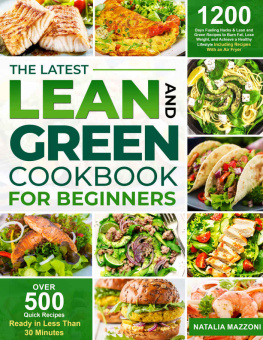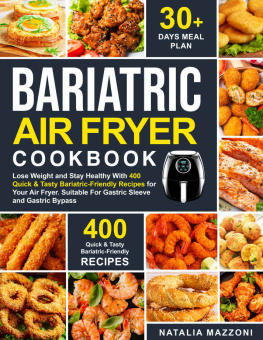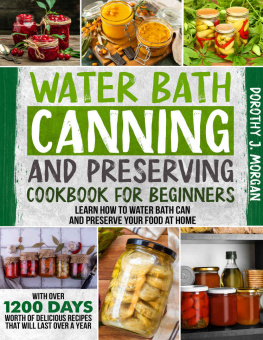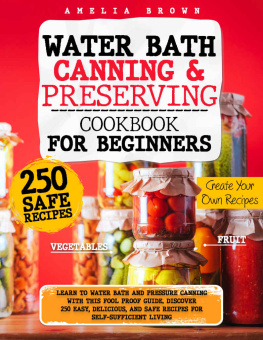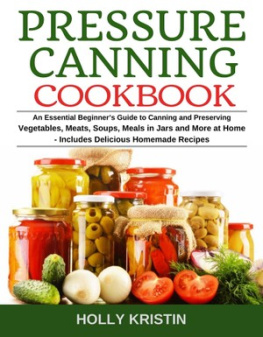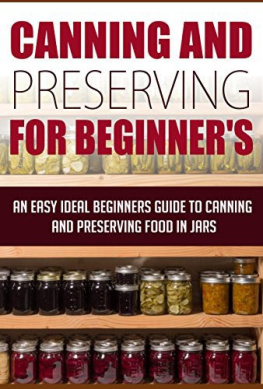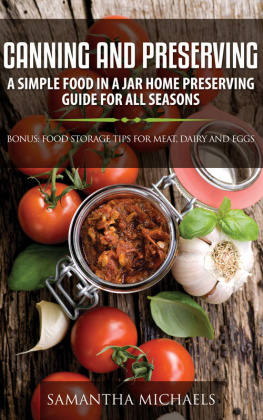Canning and Preserving Cookbook for Beginners
A Book About the Basics of Canning and Preserving Food Along with 400 Amazing Recipes
Natalia Mazzoni
Copyright 2022 by Natalia MazzoniAll rights reserved.
This document is geared towards providing exact and reliable information in regards to the topic and issue covered. The publication is sold with the idea that the publisher is not required to render accounting, officially permitted, or otherwise qualified services. If advice is necessary, legal or professional, a practiced individual in the profession should be ordered.
- From a Declaration of Principles which was accepted and approved equally by a Committee of the American Bar Association and a Committee of Publishers and Associations.
In no way is it legal to reproduce, duplicate, or transmit any part of this document in either electronic means or in printed format. Recording of this publication is strictly prohibited, and any storage of this document is not allowed unless with written permission from the publisher. All rights reserved.
The information provided herein is stated to be truthful and consistent, in that any liability, in terms of inattention or otherwise, by any usage or abuse of any policies, processes, or directions contained within is the solitary and utter responsibility of the recipient reader. Under no circumstances will any legal responsibility or blame be held against the publisher for any reparation, damages, or monetary loss due to the information herein, either directly or indirectly.
Respective authors own all copyrights not held by the publisher.
The information herein is offered for informational purposes solely and is universal as such. The presentation of the information is without a contract or any type of guarantee assurance.
The trademarks that are used are without any consent, and the publication of the trademark is without permission or backing by the trademark owner. All trademarks and brands within this book are for clarifying purposes only and are owned by the owners themselves, not affiliated with this document.
Table of Contents
Introduction
Canning appears to be somewhat outdated. A saucepan is gently filled with hot jam or pickle jars that have two-piece lids on top. These sealed, shelf-stable goods are placed on a pantry shelf after being cooked and may be used all year. However, the method of home canning as we know it is very new. Napoleon and his trials to feed an army made canning a military enterprise before and even after the invention of the self-sealing Mason jar in the 1850s. Homemakers were more inclined to preserve and store vegetables in vats of intensely salted, sweetened, and spiced vinegar brines in the nineteenth century than keep these containers in cold pantries for months at a time. The 1879 publication Housekeeping in Old Virginia had recipes for brines that used two pounds of sugar for every gallon of vinegar. It was a brine that was "strong enough to bear an egg" and was acidic enough to prevent the spoilage of almost everything. Some of the recipes in this cookbook advised brining vegetables for at least six months before using them. The variety of vegetables that were preserved in this fashion, including lemons, cabbage, green tomatoes, and melon rinds, is what makes the collection of recipes in Housekeeping so extraordinary. Reusable Mason jars and their trustworthy two-piece lids brought about a more convenient method of food preservation, but other preservation principleshow it prevents food from spoilingremained a mystery. Scientists at the USDA made a significant discovery in 1915 when they discovered the bacteria that causes botulism poisoning. Scientists eventually came up with the three safety pillars of canning: acidity, heat, and an anaerobic (airless) condition that would guarantee shelf stability. However, there is still significant disagreement over safe canning procedures between American food experts and ordinary chefs. One of the major causes of contention is the open-kettle method, in which hot food is placed into a heated jar, covered with a cap, and left on the counter to seal itself. Although this technique was widely used in the past, American food scientists no longer support it. The food still has a chance of spoiling even if the jar seals since it was never sterilized in hot water.
The strong acidity of the foods (fruits) that go into several of the preserved foods in this book, such as jams, jellies, and other sweet spreads, makes them well-suited for preservation. Some of them, like chutneys and some pickles, are concoctions of high-acid and low-acid items (such meats, all vegetables, and occasionally tomatoes), which are kept fresh by precise quantities of sugar salt, and/or vinegar. Others, like fruits and vegetables canned without sugar, salt, or vinegar, are made free of harmful toxins and hence safe to consume by processing at high temperatures for the required lengths of time.
Chapter 1: Canning and Preserving

Microorganisms, particularly molds, yeasts, and bacteria, must be removed in order to preserve food. Not all molds and yeasts in food are dangerous, as anybody who has enjoyed a slice of blue cheese or a loaf of sourdough bread will attest. Bacteria play a key role in other processes, such as the production of sauerkraut. However, generally speaking, food preservation calls for reducing microbial activity as much as is practical. It is unpleasant to open a jar of jam only to find that a mold family has moved in on the exterior. This can happen if a container is not properly sterilized. If you see mold on the surface of a preserve's jar, throw it away.) Heat, acidity, and an airtight seal work together to ensure the security of a jar's contents. Since most bacteria, yeasts, and molds frequently have low heat tolerances, heating food to the point where water boils will destroy the bulk of these microorganisms. The bulk of these spoilers also needs oxygen to survive, which is cut off by an airtight barrier. Therefore, cooking preserves in a jar while sterilizing food in a water bath destroys germs and forces air out of the jar, allowing the lid to seal when the jar cools. Even while an airtight barrier keeps oxygen and new germs out, it can also be the perfect habitat for the dangerous bacterium Clostridium botulinum. The bacteria Clostridium botulinum's spores grow in an anaerobic environment. The toxin produced by these spores, when consumed, produces botulism poisoning, a risky and occasionally fatal illness. In this case, acid is employed. Clostridium botulinum is susceptible to acid. Botulism spores need an acidic environment to survive in the jar. The other approach for eradicating botulism involves processing jars at temperatures far higher than the boiling point of water. Due to the fact that water boils at a higher temperature while under pressure, foods that are not acidic enough to avoid botulism must be processed in a pressure canner.
1.1 History of Preserving
Canning appears to be somewhat outdated. A saucepan is gently filled with hot jam or pickle jars that have two-piece lids on top. These sealed, shelf-stable goods are placed on a pantry shelf after being cooked and may be used all year. However, the method of home canning as we know it is very new. Napoleon and his trials to feed an army made canning a military enterprise before and even after the invention of the self-sealing Mason jar in the 1850s. Homemakers were more inclined to preserve and store vegetables in vats of intensely salted, sweetened, and spiced vinegar brines in the nineteenth century than keep these containers in cold pantries for months at a time. The 1879 publication Housekeeping in Old Virginia had recipes for brines that used two pounds of sugar for every gallon of vinegar. It was a brine that was "strong enough to bear an egg" and was acidic enough to prevent the spoilage of almost everything. Some of the recipes in this cookbook advised brining vegetables for at least six months before using them. The variety of vegetables that were preserved in this fashion, including lemons, cabbage, green tomatoes, and melon rinds, is what makes the collection of recipes in Housekeeping so extraordinary. Reusable Mason jars and their trustworthy two-piece lids brought about a more convenient method of food preservation, but other preservation principleshow it prevents food from spoilingremained a mystery. Scientists at the USDA made a significant discovery in 1915 when they discovered the bacteria that causes botulism poisoning. Scientists eventually came up with the three safety pillars of canning: acidity, heat, and an anaerobic (airless) condition that would guarantee shelf stability. However, there is still significant disagreement over safe canning procedures between American food experts and ordinary chefs. One of the major causes of contention is the open-kettle method, in which hot food is placed into a heated jar, covered with a cap, and left on the counter to seal itself. Although this technique was widely used in the past, American food scientists no longer support it. The food still has a chance of spoiling even if the jar seals since it was never sterilized in hot water. One woman mentioned that her grandmother used to pour the hot tomato sauce into jars, cover the jars with lids, and store them over the stove until she needed them when our co-author, Kate, and we took acidified foods canning workshop via the University of Wisconsin extension program. A jar would occasionally blow up as a result of ongoing microbiological activity. The mess would be sufficient justification for not using this approach. It is common to discover recipes for marmalades that don't call for water-bath processing after the marmalade is packed in jars, despite the fact that many well-known European jam producers support this method. The idea makes sense because marmalade is often stable on its own, the fruit has a strong acid content, and sugar itself serves as a preservative. The moment at which we can be certain that the jar, the lid, and the contents are sterilized is at least 10 minutes, yet despite this, we always boil jam jars in water. Contradictory information keeps getting spread as canning and preserving become more and more popular. In the meanwhile, cautions from jargon-filled government manuals may deter a beginner from even trying. To safely can, you don't need a doctorate or access to a sterile lab. You do need to comprehend a few truths, though.


